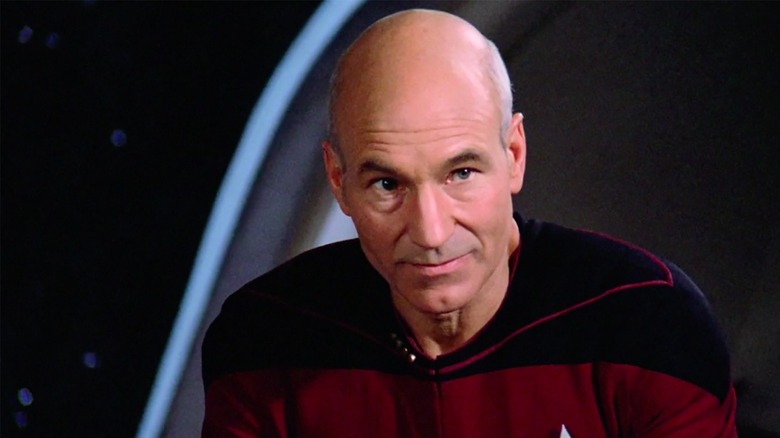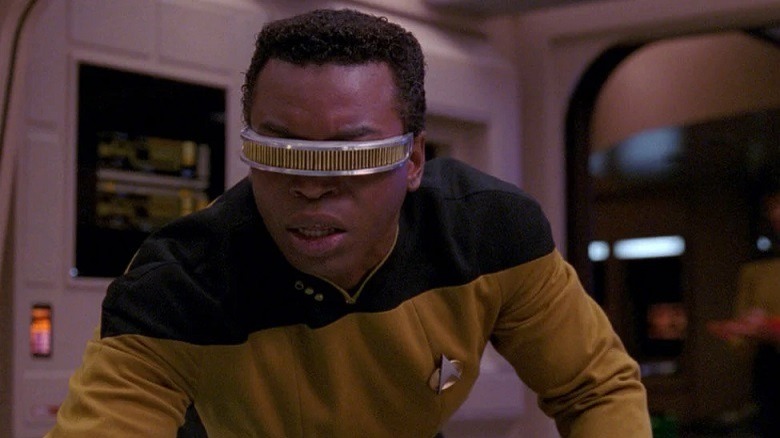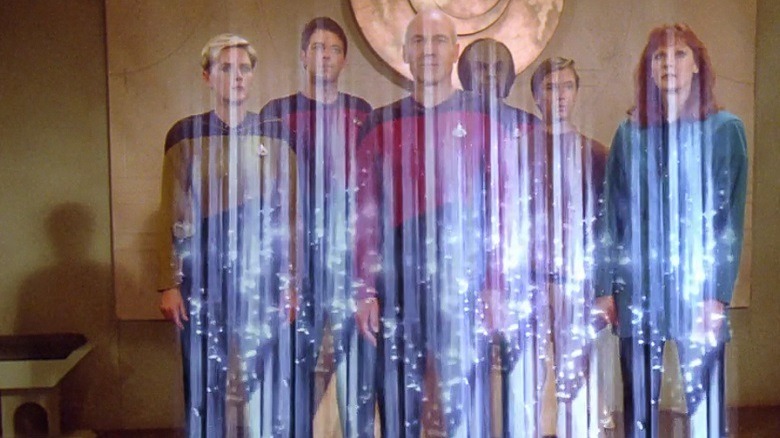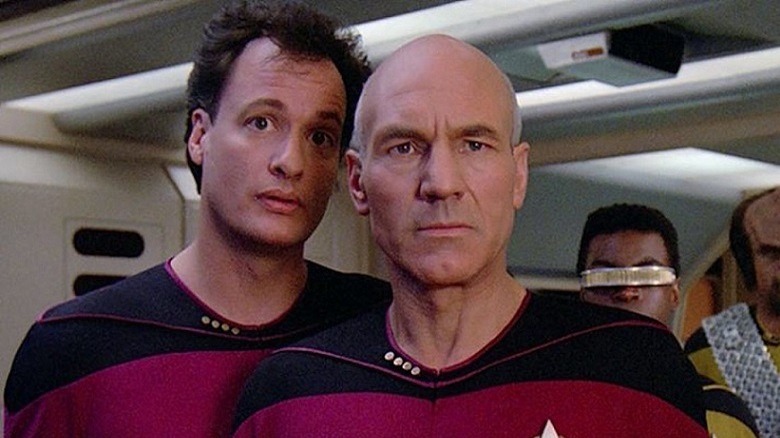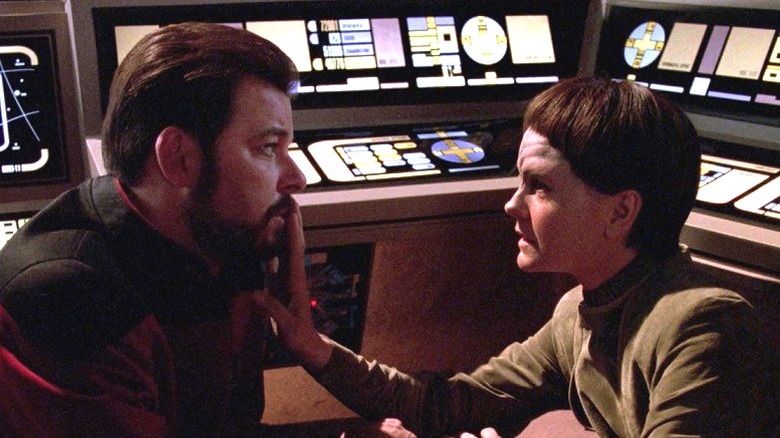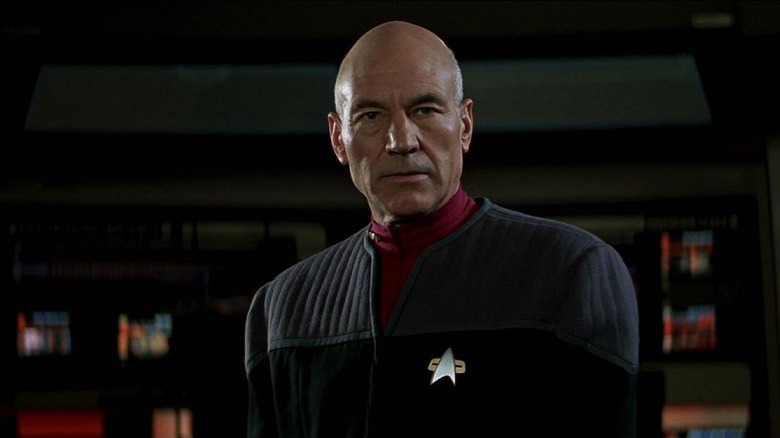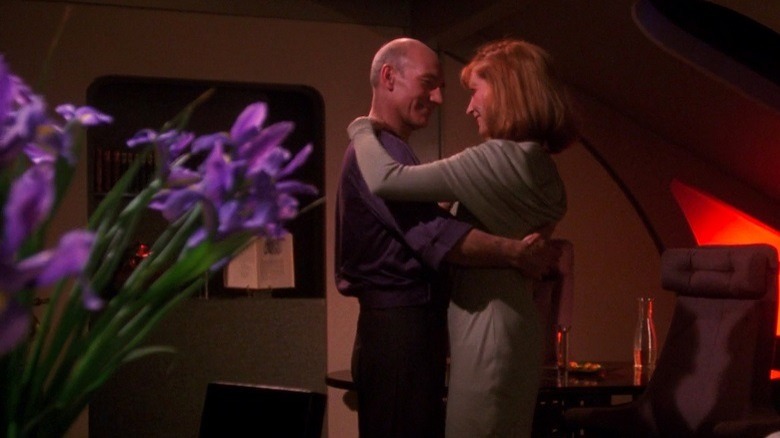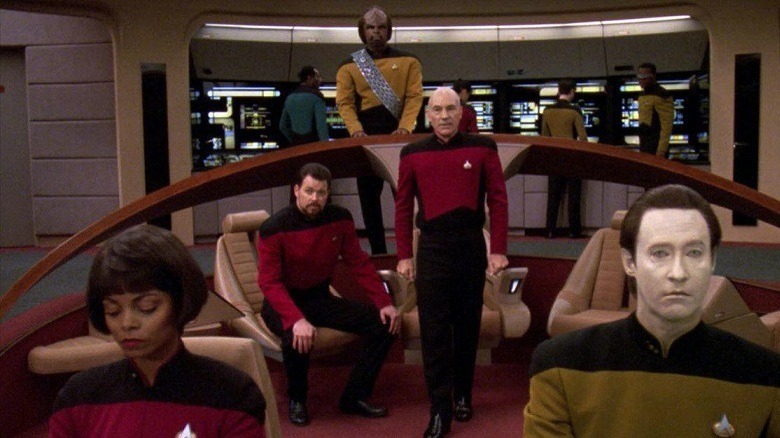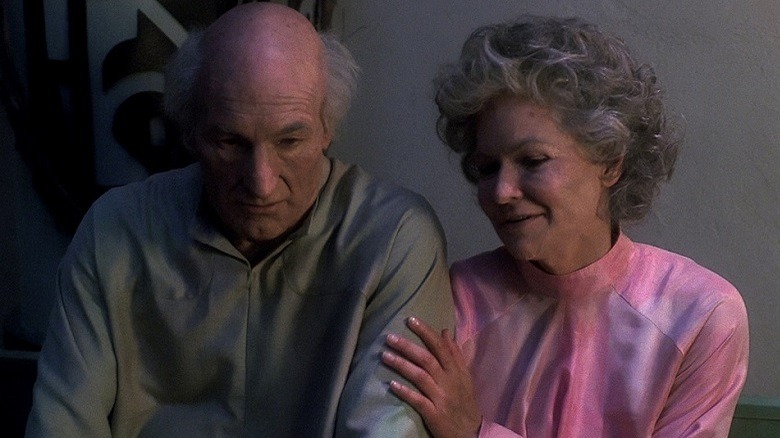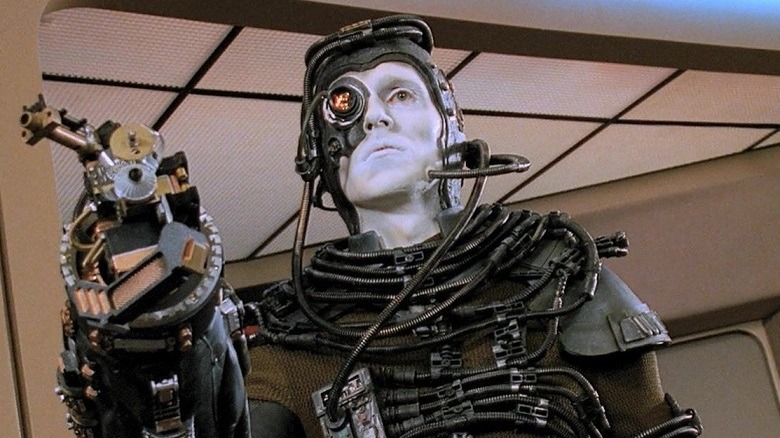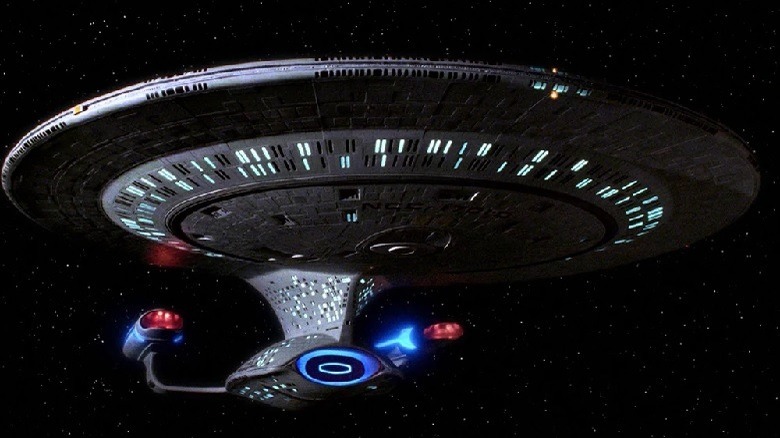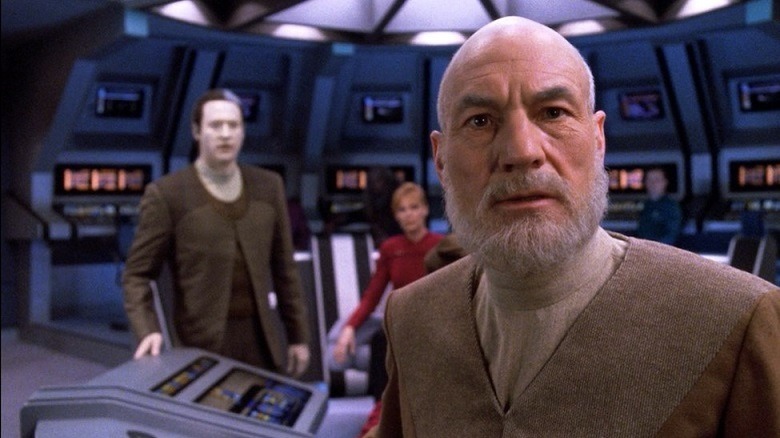11 Reasons Why The Next Generation Is The Best Star Trek Show
The last episode of "StarTrek" aired in 1969 (or 1974 if you count the animated series) and it took nearly two decades and an aborted attempt at a revival for the next "Star Trek" series to appear. The films starring the original cast were winding down when "Encounter at Farpoint," the pilot episode of "Star Trek: The Next Generation," first appeared on our screens
Introducing a brand-new crew and a ship with a familiar name but an innovative design, the episode saw our captain, the stoic Jean Luc Picard (Patrick Stewart), confront the mischievous Q (John de Lancie), a character who would go on to be his regular nemesis. The opening quote confidently declared their mission as ongoing rather than restricted to a mere five years. That optimism paid off in spades.
Paving the way for the myriad of spin-off series that would follow (as well as for genre television in general), "Star Trek: The Next Generation" would go on to tremendous success, reestablishing the foundations for the monolithic franchise that had once seemed consigned to history. It took the core established ideals of its predecessor — hopefulness, diversity, and unity — and built upon them, carving out its own path, and apart from some missteps in the first season, it never felt like a pale imitation.
So, prepare a cup of Earl Grey (piping hot, naturally), and let's boldly remind ourselves why "Star Trek: The Next Generation" was the very best that "Star Trek" had to offer.
Positive portrayals of people with disabilities
"Star Trek: The Original Series" showed us creator Gene Roddenberry's vision of the future in which humanity had put aside its petty differences in favor of exploring the final frontier. A Black female crew member took prominence in a show aired at the height of the civil rights movement, and crew members of nations that had once been bitter rivals in warfare, real or cold, comfortably shared a bridge with half-aliens.
The series also dealt with disability, depicting the ultimate fate of Capt. Pike (Jeffrey Hunter) in "The Menagerie" and the blind telepath Miranda Jones (Diana Muldaur) in "Is There in Truth No Beauty?" "Star Trek: The Next Generation" took this one step further in the form of helmsman (and later, chief engineer) Geordi La Forge. Blind from birth, Le Forge wears a VISOR, a device that permits him to "see" the electromagnetic spectrum.
Named after George La Forge, a fan of the original series who died of complications of muscular dystrophy in 1974, Geordi is equally as capable as his fellow crew members. It would have been too easy to have Geordi's disability define him, but the series is far more enlightened than that. Played by LeVar Burton (in a role that had nearly gone to Wesley Snipes), Geordi would rise through the ranks, eventually becoming a lieutenant commander, never seeing his disability as a hardship or hindrance and often referring to the advantages that the VISOR had on his engineering work.
Consistent quality
Dependent on a great deal of goodwill from its audience with fond memories of the classic series, "Star Trek: The Next Generation" might not have had the most auspicious of beginnings. Dodgy outfits aside, notably short skirts and "the skant," a great many early episodes felt like rehashes of its predecessor. It even had the utter cheek to end its second season with a half-baked clip show in the form of "Shades of Gray," an episode that upsets both my sensibilities and my English spellchecker.
Luckily, it navigated through that tricky asteroid belt to open space, and the series found its feet, becoming confident enough to boldly go where no one has gone before rather than nervously revisiting old themes. Jettisoning the apron strings through the airlock, scripts of increasingly high quality saw the series reach increasingly higher realms of critical acclaim.
The original series may have received 13 Emmy nominations, but never won a single one. "The Next Generation," however, won 18 Emmy awards over the course of its 178 episodes. There are some truly standout episodes which means the legacy of "The Next Generation" continues to shine bright.
Patrick Stewart
As an Englishman, I'm inclined towards liking a fellow tea-drinker, and Picard's love of infused boiled leaves is as much a part of his character as his stoicism, his distinctive shirt pull, or that meme — and it's now official canon that if he drank coffee, he'd be an absolute rotter.
But even more than that, what Patrick Stewart brought to the role of Gallic glabrous gallant Capt. Jean Luc Picard was some serious acting chops courtesy of a lengthy stint at the Royal Shakespeare Company. An acting heavyweight in the role grants the series an extra level of gravitas, bringing a memorable touch to even some of the weaker episodes. Whether you're fond of Q or not, there's no denying the joy of watching Stewart square off against fellow classically-trained actor John De Lancie, with both clearly having the time of their lives.
Gene Roddenberry might not have wanted him, but there's no denying the believability of Stewart in the role. On this occasion, The Great Bird of the Galaxy might have gotten it wrong. More disciplined than James T. Kirk (William Shatner), Picard is a powerful and iconic central figure who leads by example. If the hairs on the back of your neck don't stand up when Picard gives his "the line must be drawn here" speech in "Star Trek: First Contact," you're as cold and emotionless as the cybernetic foe that he's facing.
Addressing LGBTQ Issues
"Star Trek: Discovery" may have been the first "Trek" series to feature an openly gay couple in the form of Lt. Commander Paul Stamets (Anthony Rapp) and Doctor Hugh Culbert (Wilson Cruz), but in the fifth season "Star Trek: The Next Generation" episode, "The Outcast," the series tackled LGBTQ+ issues for the first time.
Relatively innocuous by today's standards, the episode saw Riker fall in love with a member of a genderless alien race known as the J'naii. The culture of this particular androgynous species forbids its populace from manifesting any male or female sexuality, viewing it as a perversion.
For a syndicated television series with a wide audience, the episode was a brave move. It's not perfect: Jonathan Frakes (Riker) thought the episode was not daring enough, wishing that Soren (the object of Riker's affections played by Melinda Culea) had been portrayed by a male actor. But in a time when these subjects were still mostly taboo, it was a refreshing move in the right direction. It's also a remarkably intimate episode that's action-light and dialogue-heavy but utterly gripping throughout. Gene Roddenberry had expressed an interest in having a gay character on the show. This wish wouldn't be realized until after his death, but this episode goes at least a little way to redress the balance.
Bigger budgets
Successful first-run syndication saw 170 television stations premiering "Star Trek: The Next Generation" back in 1989, giving each episode a budget of approximately $1.2 million. The substantial budget meant the production could procure the prodigious talents of the Lucasfilm company Industrial Light and Magic for visual effects work, including some great prototype CGI and model work for the external shots of the Enterprise. More money also meant higher quality sets and locations that didn't all resemble the same mountainous spot in the desert shot with a colored filter applied. Alien worlds felt more alien, and some excellent matte painting work and location shooting made for convincing environments and scenery.
Having grown up on a diet of "Doctor Who" and "Blake's 7" back in the '70s and '80s, with their flimsy wobbling sets and the same Yorkshire quarry posing as a remote planet, I'm reminded that low budgets are no barrier for a show that relies on the imagination and suspension of disbelief of its viewers. But "Star Trek: The Next Generation" felt expensive. There's a level of quality in each story rarely seen on episodic television, and every episode seems like a mini-movie. The budgets may have gotten bigger and the sets and effects more elaborate, but they'd be nothing without the quality of writing that the increased budget catered to.
Complex relationships
As fun as the endless sniping between Dr. McCoy (Deforest Kelly) and Mr. Spock (Leonard Nimoy) was in the classic series, "Star Trek: The Next Generation" expanded on the number of regular bridge crew and recurring cast members to create an engaging environment of more complex interpersonal relationships.
From hints of a thwarted romance between Capt. Picard and Dr. Beverley Crusher (Gates McFadden), with the captain hiding his amorous feelings behind his respect for Crusher's husband, to Tasha Yar's (Denise Crosby) troubled upbringing and similarly cruel and unexpected fate, the expanded cast seems more realistic and complex. As the series went on, characters who otherwise may have been confined to single-episode stories were developed and advanced, giving the series proper organic growth.
The crew is a family bound together by the Federation's ideals. At times, it may seem a little like the adventures of middle management in space, but these are people we genuinely cared about.
Compelling character arcs
The nature of syndication could often throttle storytelling. Because episodes were shown by multiple TV stations at multiple timeslots, stories tended to be confined to single episodes. Since they'd often be watched out of order, episodes had to end with a big reset. Nothing could happen that would change the status quo or have a dramatic effect on future episodes.
Character arcs wouldn't properly be explored in the "Star Trek" universe until 1993's "Star Trek: Deep Space Nine," but "Star Trek: The Next Generation" wasn't afraid to develop its characters and themes. Multi-part stories popped up frequently, using their expanded time to tell deeper and more involved tales.
Data's (Brent Spiner) ongoing quest for humanity was a particular highlight that would eventually overlap with the subsequent "Next Generation" movies. Worf's (Michael Dorn) ongoing quest to regain his honor would even crossover an entire series into his regular role on "Star Trek: Deep Space Nine." Picard's trauma at the cybernetic hands of the Borg echoes throughout the entire series and is expanded upon even further in the spin-off series "Picard."
It's more cerebral
The Prime Directive, that powerful Federation mantra that forbids interference with other cultures, often seems more like a suggestion than a rule to headstrong Capt. James T. Kirk. There were few problems that Kirk couldn't solve with a well-aimed phaser or a double-fisted punch. The 1960s were simpler times when evil computers could be confused into blowing themselves up by confronting them with an unsolvable logic puzzle, and mischievous godlike beings could be thwarted with a good scolding from their equally godlike parents.
Of course, there were exceptions. Harlan Ellison's "The City on the Edge of Forever" is one of the greatest, most thoughtful pieces of sci-fi ever conceived. "Star Trek: The Next Generation" took this to the next level. More cerebral than the original, it covers complex issues such as human rights, racism, and euthanasia, rarely lapsing into heavy-handed moralizing. Although "Quantum Leap" would later show how perfect sci-fi is for exploring deeper themes, "Star Trek" did it first.
It is telling that some of the best-received episodes are the ones that don't adhere to the standard spaceships and rayguns tropes of sci-fi at all. "The Inner Light" deals with tradition, societal values, and legacy. "Half a Life" concerns itself with the quandaries of euthanasia and how a society treats its elderly.
The Borg
Replacing the now allied Klingon Empire, the avaricious Ferengi were originally posited as the new antagonistic race in "Star Trek: The Next Generation." However, this was ultimately flawed, as the series failed to ever show them as a real threat. It's difficult to find any real menace in a group of greedy space-faring lawyers, and the show struggled to show them as anything but comedic foils.
Luckily, "Q Who" saw the introduction of a new, genuinely terrifying enemy from the far reaches of space. Similar to Doctor Who's Cyberman, the Borg were like nothing ever seen in "Star Trek" — more force of nature than foe. An all-conquering, all-absorbing species that adds the biological and technological distinctiveness of any species they meet to their own, the Borg are dedicated to growing and improving, with no regard to the beings they assimilate into their collective.
This foe is immune to the Federation's best weapon: diplomacy. The Borg would wreak havoc through the remainder of the series in conflicts that had serious, lasting ramifications for Capt. Picard. Overuse of the bio-organic baddies eventually defanged and demystified them slightly. We even see one join the bridge crew in "Star Trek: Voyager." Still, they remain a credible and genuinely unnerving threat.
The Borg made "Star Trek: The Next Generation" great. Disturbing body horror might have seemed out of place on a tea-time science fiction show, but resistance to their appeal is futile.
It made science fiction on television popular
Back in 1987, television was quite different. In the US, there were only four prime-time networks and a small number of cable networks. "Star Trek: The Next Generation" faced extraordinarily little competition. Over here in the UK, it might have been released to BBC 2, the little sister of BBC 1, but it received a prime-time slot. That was virtually unheard of in genre television.
"Star Trek: The Next Generation" was a phenomenon. Believing that the series was doomed to failure, Patrick Stewart took the role because he thought it'd be an opportunity to make some proper money before its inevitable cancellation. However, the show was an incredible success, attracting nearly 12 million viewers at its peak.
CGI, which was in its infancy at the dawn of "Star Trek: The Next Generation," would make the impossible possible and more importantly, affordable. A myriad of other science fiction series may have sprung up after it, but they were all traveling in the wake of the USS Enterprise. "Star Trek: The Next Generation" showed that there was a healthy market for science-fiction and genre television.
The ending
Although the cast had been secured for an eighth season, it was decided to end "Star Trek: The Next Generation" after the seventh. Ratings, though still relatively healthy, had waned, and ending the show before interest dwindled completely would give "Star Trek: Deep Space Nine" and the forthcoming "Generations" film starring the "Next Generation" cast a fighting chance.
Of course, the series still needed to end on a high note. History is littered with successful series that failed to stick the landing, but the double-length episode, "All Good Things," stands as some of the best "Trek" to date. Featuring another appearance from Q to bookend it neatly with "Encounter at Farpoint," the series' pilot episode, it's a time-spanning epic that is as confident at revisiting the past as it is dealing with the characters' possible futures. It's a touching and poignant farewell to much-loved characters that was watched by more than 31 million viewers.
"Star Trek: The Next Generation" left a strong legacy. It lasted twice as long as its predecessor and would go on to spawn four movies starring the cast (some of whom would return for "Picard"). Back in 1987, who would have guessed that the continuing mission would still be going strong in the 21st century?
